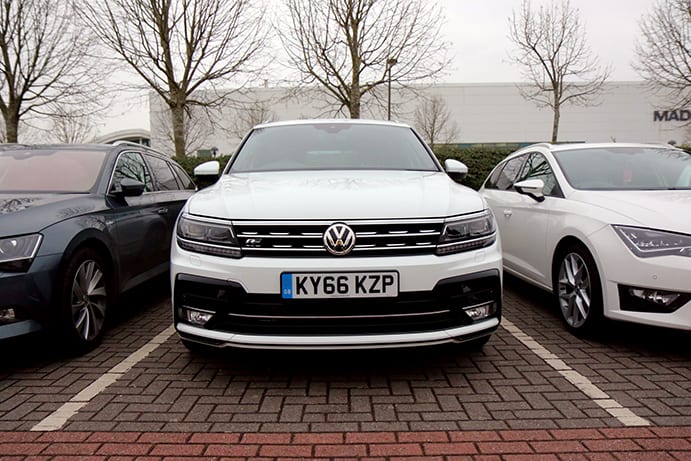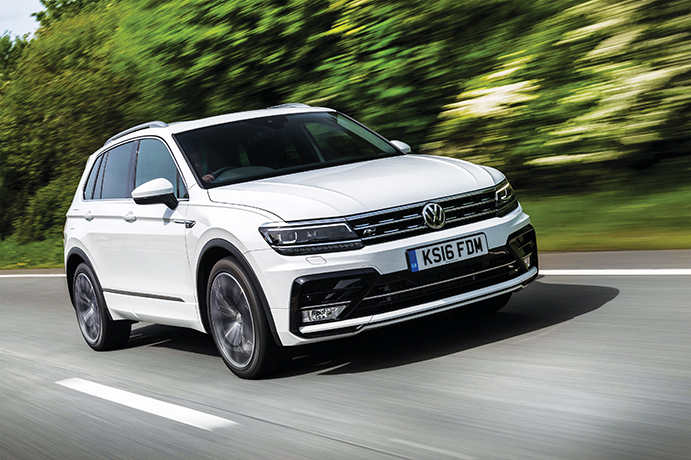The VW Tiguan’s self-parking function is a tangible demonstration of the power of driverless technology. Chris Pickering reports
If you ask a typical person what their least favourite aspect of driving is, there’s a very good chance the response will be ‘parking’. And not without reason. Squeezing into a tight spot is
the most complex test of spatial awareness that most people will encounter behind the wheel.
In fact, in a recent survey of British drivers, one in four admitted to often parking ‘some distance’ from where they needed to be in order to find an easier space.
Fortunately, technology has the answer. Assisted-parking systems have been around for more than a decade now. Although some, it has to be said, are more adept than others.

Today we’ve come to Volkswagen’s UK base in Milton Keynes to try the Park Assist function on the new Tiguan. As modern SUVs go, the Tiguan’s visibility is actually very good. You don’t find yourself peering out of a letterbox-slot-sized rear window as you do in some of the more coupé-like crossovers. Nonetheless, it is a fairly sizeable high-riding vehicle, so it’s exactly the sort of application where this system should come into its own.
Park Assist relies on 12 ultrasonic sensors – six in the rear bumper and six in the front. In both cases these wrap round the corners of the bumper, giving 360 degrees of combined visibility. They are networked over the vehicle’s CAN bus to a dedicated Park Assist control unit, which
sends instructions to another ECU in charge of the electrically assisted power steering.
The system is primed by prodding a button on the centre console. It allows you to toggle between reverse parking and parallel parking modes, after which you can drive forwards at up to 25mph and the system will start scanning away. Once it finds a suitable space, a graphic comes up in the instrument cluster indicating that you’re ready to go.
As you’d expect, there are a series of safety functions built in to stop you doing anything stupid. For a start, the system won’t trigger if it detects that the vehicle is towing a trailer; it also doesn’t allow you to pick spots on tight bends and there’s a 4mph speed limit (plus an emergency braking function) during the manoeuvre itself.
You retain control of the brake and the accelerator at all times, but as soon as you move off the car takes over the steering. It’s a real leap of faith the first time, with the car happy to get quite close to neighbouring vehicles before it emits a cheerful ping, telling you to change into Drive to go forwards. Again, the steering wheel spins in front of your eyes until you’re summoned to go into reverse.

Depending on how well you’ve positioned the car in the first place it can take a few bites, but no more than the average human driver would do in the same situation. Interestingly, the system remains active if you chicken out before the tone sounds, so you can leave as much margin for error as you like – handy if it’s the first time you’ve tried it and your scientifically controlled test environment happens to be the local Sainsbury’s car park.
In some respects, watching the steering wheel whirl back and forth at 2mph in a car park is actually a more tangible demonstration of a vehicle’s self-driving capabilities than one that can steer itself at 70mph on a motorway. Once you learn to trust the system you can reverse quite rapidly, and it generally manages to steer into the space in one go.
The parallel parking mode is equally accomplished, guiding you into spaces that even the most confident drivers might think twice about tackling in an unfamiliar car. It can also steer you out of them, which can be just as important if you can’t see the extremities of the front bumper.
There are a few limitations to bear in mind. Because the system relies on ultrasonic reflections it can’t park unless there’s a car (or some other obstacle) to serve as a reference point. It also means you’re at the mercy of other people’s positioning – so if the cars on either side are off-centre, your miraculous parking skills will appear to have taken
a downturn.
Aside from those, the only issue we could see is that it doesn’t always pick up on a space; sometimes it takes a couple of attempts to register the same spot, even though the speed and angle of approach are more or less identical. Generally, though, it is very good. Assisted parking may sound like a gimmick, but we suspect a lot more than one in four drivers would secretly use it.




April 1886: the Brunkebergs tunnel
First ever example of a ground source heat pump?